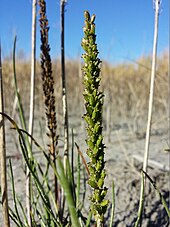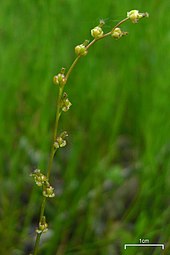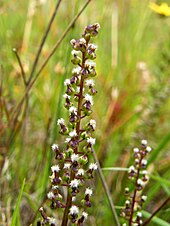Trident
| Trident | ||||||||||||
|---|---|---|---|---|---|---|---|---|---|---|---|---|

Swamp trident ( Triglochin palustris ) |
||||||||||||
| Systematics | ||||||||||||
|
||||||||||||
| Scientific name | ||||||||||||
| Triglochin | ||||||||||||
| L. |
The trident ( Triglochin ) are a genus of plants within the trident family (Juncaginaceae). The 25 or so species thrive as marsh plants in temperate to circumboreal areas and are distributed almost worldwide.
description



Appearance and leaves
Triglochin species are often persistent or, less frequently , annuals (annuals are, for example, Triglochin hexagona , Triglochin minutissima , Triglochin mucronata , Triglochin muelleri , Triglochin protuberans , Triglochin stowardii , Triglochin trichophora ) herbaceous plants . They often form thick, stocky rhizomes as permanent organs; they form many unbranched roots at their nodes. Depending on the species, there are upright, short or barely recognizable stems . The above-ground parts of the plant are more or less bare.
The alternate and spiral, more or less densely arranged in basal rosettes or arranged in two rows, medium to very large leaves are divided into leaf sheath and leaf blade. In some species, the leaves are with the narrow side to the stem axis . The edges of the membranous leaf sheath are free. The Ligule (Ligula) are undivided or two-lobed. The simple, parallel-veined leaf blades are, depending on the species, more or less flat, belt-shaped, linear, petiolate or half-petiolate.
Inflorescences and flowers
On bare slender cylindrical Blütenstandsschäften, the or shorter depending on the type than the leaves, are traubige inflorescences . The flower stalks are short.
The flowers are mostly hermaphroditic and threefold. Triglochin scilloides differs from the other species in that there can also be pure male flowers in one inflorescence and the flower parts can be reduced to two to one; this is also why this species was placed in its own genus. The inflorescence consists of one or two circles, each with three sepal-like free scales, which are usually green with a concave inside. There are two circles with three fertile stamens each or one circle is reduced; rarely is only one stamen present. The stamens are missing or very short. The papillary or about feathered, extrorsen, tetrasporangiaten dust bag are relatively wide and öffenen with a longitudinal slot. The three or six carpels are a top permanent, unilocular ovary fused; if there are six carpels, all or only three may be fertile . There is only one anatropic ovule per carpel in a basal or central angled placentation . The short to barely discernible stylus ends in a papillary scar .
Fruits and seeds
The spherical to linear fruit is interpreted as a follicle fruit or split fruit , and when ripe splits from bottom to top into three or six single-seeded partial fruits. The relatively small, starchy seeds are cylindrical, linear in cross section and more or less flat to angular and without endosperm . The seed coat (testa) is relatively thin. The straight embryo has a germ layer ( cotyledons ).
Ingredients and sets of chromosomes
Fresh plant parts are poisonous due to hydrocyanic acid compounds.
The basic chromosome number is x = 6. The species have different degrees of ploidy ; were chromosome numbers of 2n = 12, 18, 24, 36, 48, etc. found in up to the 144th
ecology
Triglochin species often thrive terrestrially or aquatically in wet locations, in swamps often with salty soils or in brackish water or seasonal ponds . They are helophytic or hydrophytic hydrophytes that are always rooted in the soil. The leaves are rarely under water; so they are mostly emersed or rarely submerged .
The pollination is carried by the wind ( anemophily ).
Systematics


The genus Triglochin was established by Carl von Linné in 1753 in Species Plantarum , Volume 1, p. 338. The generic name Triglochin is derived from the Greek words treis for three and glochis for point, this refers to the three-pointed fruits of some species. Triglochin palustris L. was specified as the lectotype species in 1909 by Nathaniel Lord Britton in North American Flora , Volume 17, p. 41. Synonyms for Triglochin L. are Abbotia Raf. , Juncago Ség. nom. superflat., Heterostylus Hook. , Hexaglochin Nieuwl. According to molecular genetic studies, the monotypic genus has been Lilaea Bonpl since 2010 . contained in triglochin .
The Triglochin species thrive in temperate to circumboreal areas in the northern and southern hemispheres . The focus of species diversity is on the southern hemisphere in Australia (14 species in all states) and South Africa (6 species mainly in the Capensis ).
The genus Triglochin includes about 25 species:
- Triglochin barrelieri Loisel. (Syn .: Triglochin bulbosa subsp. Barrelieri (Loisel.) Rouy ): It iswidespreadin the Mediterranean region .
- Triglochin Buchenaui Kätze, Mering & Kadereit : It was first described in 2010 andonlythrivesin the South African provinces of Eastern Cape and Western Cape in periodically flooded locations along low-lying salt marsh estuaries from Velddrif to Kenton-on-Sea.
-
Triglochin bulbosa L .: There are four subspecies:
- Triglochin bulbosa L. subsp. bulbosa : It occurs from Calvinia to the West Coast, on the Cape Peninsula and on the Agulhas Plain only in the South African provinces of North Cape and Western Cape.
- Triglochin bulbosa subsp. calcicola Mering, Kätze & Kadereit : It was first described in 2010 and thrives in coastal areas from the Vredenburg peninsula to False Bay and east to the Agulhas plain and Stilbaai only in the South African province of Western Cape.
- Triglochin bulbosa subsp. quarcicola Mering, Kätze & Kadereit : This endemic was first described in 2010 and only occurs in three locations in Knersvlakte in the South African province of Western Cape.
- Triglochin bulbosa subsp. tenuifolia (Adamson) Horn : This endemic occurs from the Vredenburg Peninsula to the Cape Peninsula only in the South African province of Western Cape.
- Triglochin calcitrapa hook. : It is common in the Australian states of Queensland , New South Wales , Northern Territory , Victoria , Western Australia and South Australia .
- Triglochin centrocarpa hook. : It is common in the Australian states of Queensland, New South Wales, Northern Territory, Victoria, Western Australia, South Australia and Tasmania .
- Triglochin compacta Adamson : It occurs from the southern Namaqualand and "Bokkeveld Escarpment" south to the Cape Peninsula and east to Knysna only in the South African provinces of the Northern and Western Cape.
- Triglochin elongata Buchenau : It is distributed in the South African provinces of KwaZulu-Natal , Eastern, Western and Northern Cape.
- Triglochin gaspensis Lieth & D.Löve : It thrives in eastern North America at an altitude of about sea level in the eastern Canadian provinces of New Brunswick , Nova Scotia , Prince Edward Island , Québec as well as on the island of Newfoundland and in the eastern USA only in the state of Maine .
- Triglochin hexagona J.M.Black : It is distributed in the Australian states of New South Wales, Northern Territory, Western Australia and South Australia.
- Triglochin isingiana (JMBlack) Aston : It is common in the Australian states of Victoria, Northern Territory, Western Australia and South Australia.
- Triglochin laxiflora cast. (Syn .: Triglochin bulbosa subsp. Laxiflora (Guss.) Rouy ): It iswidespreadin the western and central Mediterranean region.
- Triglochin longicarpa (Eastern) Aston : It occurs only in the Australian state of Western Australia.
- Beach trident ( Triglochin maritima L. ): It is widespread in temperate areas in the northern hemisphere and in southern South America.
- Triglochin mexicana Kunth : It occurs in central Mexico to Michoacán .
- Triglochin milnei horn : It is distributed from Tanzania to Angola and in the South African provinces of Mpumalanga and KwaZulu-Natal.
- Triglochin minutissima F. Muell. : It is common in the Australian states of Victoria, Western Australia, South Australia and Tasmania.
- Triglochin mucronata R.Br. : It is common in the Australian states of Victoria, Western Australia, South Australia and Tasmania.
- Triglochin muelleri Buchenau : It occurs only in the Australian state of Western Australia.
- Marsh trident ( Triglochin palustris L. , syn .: Triglochin juncea Gilib. , Triglochin palustris var. Salina Mert. & WDJKoch , Triglochin chilensis Meyen , Triglochin himalensis Royle , Triglochin fonticola Phil. , Triglochin andina Phil. , Triglochin komarovii Lipsch. & Pavlov ): It is widespread in the temperate areas almost worldwide.
- Triglochin protuberans Aston : It occurs only in the Australian state of Western Australia.
- Triglochin scilloides (Poir.) Mering & Kadereit (Syn .: Phalangium scilloides Poir. , Anthericum scilloides (Poir.) Schult. & Schult. F. , Liliago scilloides (Poir.) C. Presl , Lilaea scilloides (Poir.) Hauman , Lilaea subulata Humb. & Bonpl. , Heterostylus gramineus Hook. , Lilaea superba Rojas ): It iswidespreadin the New World from Canada to Mexico and in western and southern South America .
- Triglochin stowardii N.E.Br. : It occurs only in the Australian state of Western Australia and maybe in South Australia.
- Triglochin striata Ruiz & Pav. (Syn .: Triglochin triandra Michx. , Triglochin decipiens R.Br. , Tristemon triander (Michx.) Raf. , Triglochin montevidensis Spreng. , Triglochin filifolia Sieber ex Spreng. , Triglochin flaccida A.Cunn. , Triglochin densiflora Dombey ex Kunth , Triglochin lechleri Steud. , Triglochin atacamensis Phil. , Triglochin litorea Phil. , Triglochin littoralis Phil. ex Micheli , Triglochin floridana Gand. , Triglochin natalensis Gand. , Triglochin neozelandica Gand. , Triglochin philippii Gand. , Triglochin pycnostachya Gand. , Triglochin pumila Larrañaga Triglochin striata var. Montevidensis (Spreng.) Buchenau , Triglochin striata var. Triandra (Michx.) Buchenau , Triglochin striata var. Filifolia (Sieber ex Spreng.) Micheli , Triglochin striata var. Triglochin striata var. Humilis Micheli , Triglochin striata varvar. robustior Micheli ): The subtaxa described are all synonyms. It iswidespreadfrom Zaire to South Africa (KwaZulu-Natal, Eastern and Western Cape) and in Madagascar only in the province of Toliara , in Australia, New Zealand and in the Neotropics .
- Triglochin trichophora Nees ex Endl. : It is common in the Australian states of Victoria, Western Australia and South Australia.
- Triglochin turrifera Ewart : It is common in the Australian states of New South Wales, Victoria and South Australia.
Since 2010 no longer to the genus Triglochin , but to the reactivated genus Cycnogeton Endl. mainly found in Australia include:
- Triglochin alcockiae Aston → Cycnogeton alcockiae (Aston) Mering & Kadereit
- Triglochin dubia R.Br. → Cycnogeton dubium (R.Br.) Mering & Kadereit
- Triglochin huegelii (Endl.) Aston → Cycnogeton huegelii Endl.
- Triglochin linearis Endl. → Cycnogeton linear (Endl.) Sond.
- Triglochin microtuberosa Aston → Cycnogeton microtuberosum (Aston) Mering & Kadereit
- Triglochin multifructa Aston → Cycnogeton multifructum (Aston) Mering & Kadereit
- Triglochin procera R.Br. → Cycnogeton procerum (R.Br.) Buchenau
- Triglochin rheophila Aston → Cycnogeton rheophilum (Aston) Mering & Kadereit
use
Triglochin maritima and Triglochin palustris were used in many ways. Only the white base of the vegetative (not flowering) parts of the plant can be eaten raw or cooked; it is best picked in late spring when it has a mild, sweet taste similar to that of cucumber. An unpleasant odor arises during cooking. The green parts of the plant should not be eaten, as hydrogen cyanide glycosides make them poisonous. The seeds are roasted and ground into flour. The roasted seeds can be used as a coffee substitute.
The ashes from Triglochin maritima are rich in potassium and were used to make soap .
Ethnobotany
Of the indigenous peoples of the North American Great Basin and California was Triglochin maritima versatile. The seeds were roasted and ground and used as food. Caution, raw, the seeds and other parts of the plant are poisonous due to hydrogen cyanide. Roasted seeds have also been used as a coffee substitute. The dried or fresh vegetative parts of the plant were eaten cooked as vegetables.
literature
- AV Köck, Sabine von Mering, L. Mucina, Joachim W. Kadereit: Revision of the Mediterranean and Southern African Triglochin bulbosa complex (Juncaginaceae). In: Edinburgh Journal of Botany , Volume 67, 2010, pp. 353-398.
- Sabine von Mering, Joachim W. Kadereit: Phylogeny, Systematics, and Recircumscription of Juncaginaceae - A Cosmopolitan Wetland Family. In: Diversity, Phylogeny, and Diversity of the Monocotyledons , Proceedings of the Fourth International Conference on the Comparative Biology of the Monocotyledons. Aarhus University, 2010, pp. 55-79. Full text PDF. (Section systematics with dissemination)
- HR Coleman, 2008: Triglochin L. - Datasheet from the Western Australian Flora .
Individual evidence
- ↑ a b c d e f g h i j k l James Edgar Dandy : Triglochin L. In: Thomas Gaskell Tutin et al .: Flora Europaea . Volume 5, pages 6-7. Cambridge University Press 1980. ISBN 0-521-20108-X
- ↑ a b c d e f g h i j k l m n o p q r s Robert F. Thorne, 1993: Triglochin L. - data sheet at Jepson Manual Treatment .
- ↑ a b c d e f g h i j k l m n Rafaël Govaerts (Ed.): Triglochin. In: World Checklist of Selected Plant Families (WCSP) - The Board of Trustees of the Royal Botanic Gardens, Kew . Retrieved August 28, 2014.
- ↑ a b c d e f g h i j k l m Robert R. Haynes, C. Barre Hellquist: Juncaginaceae. : Triglochin Linnaeus , pp. 44–46 - the same text online as the printed work , In: Flora of North America Editorial Committee (ed.): Flora of North America North of Mexico. Volume 22: Magnoliophyta: Alismatidae, Arecidae, Commelinidae (in part), and Zingiberidae , Oxford University Press, New York and Oxford, 2000. ISBN 0-19-513729-9
- ↑ a b c d e f Youhao Guo, Robert R. Haynes, C. Barre Hellquist: Juncaginaceae. : Triglochin Linnaeus , p. 105 - online with the same text as the printed work , In: Wu Zheng-yi, Peter H. Raven, Deyuan Hong (ed.): Flora of China. Volume 23: Acoraceae through Cyperaceae , Science Press and Missouri Botanical Garden Press, Beijing and St. Louis, 2010. ISBN 978-1-930723-99-3
- ↑ a b c d e f g h i j k l HR Coleman, 2008: Triglochin L. - Data sheet at the Western Australian Flora .
- ↑ a b c d e f g SWL Jacobs: Triglochin. : Datasheet of the New South Wales Flora Online at PlantNET - The Plant Information Network System of The Royal Botanic Gardens and Domain Trust, Sydney, Australia .
- ↑ a b c d e f g h i j David J. Keil, 2013: Triglochin L. at Jepson eFlora
- ^ Robert F. Thorne, 1993: Lilaea Bonpl. - Datasheet at Jepson Manual Treatment .
- ↑ a b c d Triglochin at Tropicos.org. In: Flora of Pakistan . Missouri Botanical Garden, St. Louis
- ^ A b c d e Sabine von Mering, Joachim W. Kadereit: Phylogeny, Systematics, and Recircumscription of Juncaginaceae - A Cosmopolitan Wetland Family. In: Diversity, Phylogeny, and Diversity of the Monocotyledons , Aarhus University, 2010, pp. 55-79. Full text PDF.
- ^ Triglochin at Tropicos.org. In: IPCN Chromosome Reports . Missouri Botanical Garden, St. Louis
- ^ Linnaeus scanned in at biodiversitylibrary.org in 1753 .
- ↑ a b Triglochin at Tropicos.org. Missouri Botanical Garden, St. Louis, accessed on August 28, 2014.
- ^ Triglochin in the Germplasm Resources Information Network (GRIN), USDA , ARS , National Genetic Resources Program. National Germplasm Resources Laboratory, Beltsville, Maryland. Retrieved August 28, 2014.
- ↑ a b c d e f g h i j k l m Triglochin L. - Data sheet at APNI = Australian Plant Name Index .
- ↑ a b c d e f g h i j List of species for Triglochin in the Red List of South African Plants
- ↑ a b c d USDA data sheet: Triglochin .
- ↑ a b Friedrich Markgraf : Juncaginaceae trident family . In: Gustav Hegi : Illustrated flora of Central Europe . 3rd edition, Volume I, Part 2: Gymnospermae, Angiospermae: Monocotyledoneae 1 (Alismataceae - Scheuchzeriaceae) , Paul Parey, Berlin / Hamburg 1981, pages 198-203. ISBN 3-489-51020-8
- ↑ a b Triglochin at Tropicos.org. In: Bolivia Checklist . Missouri Botanical Garden, St. Louis
- ^ Triglochin at Tropicos.org. In: Catalog of the Vascular Plants of Madagascar . Missouri Botanical Garden, St. Louis
- ^ Triglochin at Tropicos.org. In: Peru Checklist . Missouri Botanical Garden, St. Louis
- ↑ Cycnogetone Endl. - Data sheet at APNI = Australian Plant Name Index .
- ↑ a b Entries on triglochin in Plants For A Future
- ^ Peter Goodchild: Survival Skills of the North American Indians . Chicago Review Press, 1999, ISBN 978-1-56976-503-6 , pp. 216 ( Triglochin on p. 216 in the Google book search).
- ↑ Triglochin maritima - data sheet ( page no longer available , search in web archives ) Info: The link was automatically marked as defective. Please check the link according to the instructions and then remove this notice. at Moerman's Native American Ethnobotany Database


